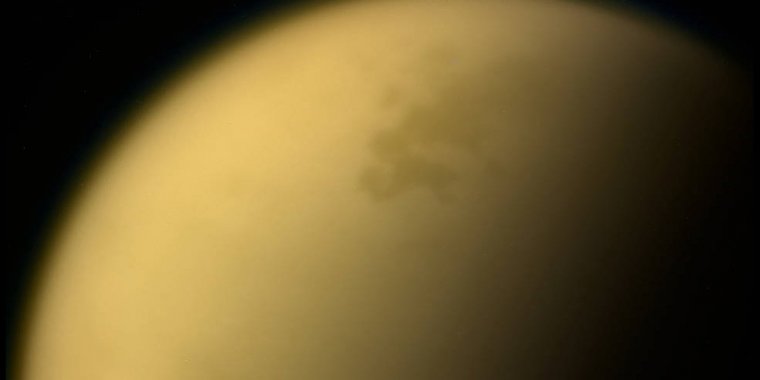| News / Space News |
NASA Team Finds Noxious Ice Cloud on Saturn’s Moon Titan
Researchers with NASA’s Cassini mission found evidence of a toxic hybrid ice in a wispy cloud high above the south pole of Saturn’s largest moon, Titan.

This view of Saturn’s largest moon, Titan, is among the last images the Cassini spacecraft sent before it plunged into the giant planet’s atmosphere. ![]()
The finding is a new demonstration of the complex chemistry occurring in Titan’s atmosphere—in this case, cloud formation in the giant moon’s stratosphere—and part of a collection of processes that ultimately helps deliver a smorgasbord of organic molecules to Titan’s surface.
Invisible to the human eye, the cloud was detected at infrared wavelengths by the Composite Infrared Spectrometer, or CIRS, on the Cassini spacecraft.
Located at an altitude of about 100 to 130 miles (160 to 210 kilometers), the cloud is far above the methane rain clouds of Titan’s troposphere, or lowest region of the atmosphere. The new cloud covers a large area near the south pole, from about 75 to 85 degrees south latitude.
Laboratory experiments were used to find a chemical mixture that matched the cloud’s spectral signature -- the chemical fingerprint measured by the CIRS instrument.
The experiments determined that the exotic ice in the cloud is a combination of the simple organic molecule hydrogen cyanide together with the large ring-shaped chemical benzene. The two chemicals appear to have condensed at the same time to form ice particles, rather than one being layered on top of the other.
This cloud represents a new chemical formula of ice in Titan’s atmosphere. What’s interesting is that this noxious ice is made of two molecules that condensed together out of a rich mixture of gases at the south pole.
Previously, CIRS data helped identify hydrogen cyanide ice in clouds over Titan's south pole, as well as other toxic chemicals in the moon's stratosphere.
In Titan’s stratosphere, a global circulation pattern sends a current of warm gases from the hemisphere where it’s summer to the winter pole. This circulation reverses direction when the seasons change, leading to a buildup of clouds at whichever pole is experiencing winter.
Shortly after its arrival at Saturn, Cassini found evidence of this phenomenon at Titan’s north pole. Later, near the end of the spacecraft’s 13 years in the Saturn system, a similar cloud buildup was spotted at the south pole. (NASA)
YOU MAY ALSO LIKE



